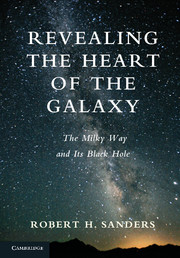Book contents
- Frontmatter
- Contents
- Acknowledgements
- 1 Introduction: The Luminous Pathway
- 2 The Discovery of the Milky Way Galaxy
- 3 The New Physics
- 4 Parting the Veil with Radio Astronomy
- 5 The Violent Universe
- 6 New Windows on the Galactic Center
- 7 The Milky Way as a Barred Spiral Galaxy
- 8 The Evolving View of Active Galactic Nuclei
- 9 The “Paradox of Youth”: Young Stars in the Galactic Center
- 10 Stellar Orbits in the Galactic Center, QED
- 11 Black Holes Here, Black Holes There…
- 12 Traces of Activity: Past, Present, and Future
- 13 After Words: Progress in Astronomy
- References
- Index
1 - Introduction: The Luminous Pathway
Published online by Cambridge University Press: 05 December 2013
- Frontmatter
- Contents
- Acknowledgements
- 1 Introduction: The Luminous Pathway
- 2 The Discovery of the Milky Way Galaxy
- 3 The New Physics
- 4 Parting the Veil with Radio Astronomy
- 5 The Violent Universe
- 6 New Windows on the Galactic Center
- 7 The Milky Way as a Barred Spiral Galaxy
- 8 The Evolving View of Active Galactic Nuclei
- 9 The “Paradox of Youth”: Young Stars in the Galactic Center
- 10 Stellar Orbits in the Galactic Center, QED
- 11 Black Holes Here, Black Holes There…
- 12 Traces of Activity: Past, Present, and Future
- 13 After Words: Progress in Astronomy
- References
- Index
Summary
Nothing can be more spectacular than the nocturnal moonless sky, far from big city lights and haze. This is especially true in the summer, or so it seemed to me in the small Texas town of my childhood. Even in that soupy semitropical climate near the Gulf of Mexico there were nights when the sky was brilliant with stars of all brightness and colors. It appeared to me not as a flat canopy but as a void with depth – three-dimensional – the brighter objects so close that I could almost touch them and the fainter ones fading away to infinity. And through it all ran the luminous band of the Milky Way flowing north to south from Cassiopeia down to Sagittarius with a conspicuous bifurcation halfway between in Cygnus. What was it? What comprised this shining ribbon, present in the same form night after night in the summer sky? I think that it was the appearance of the Milky Way that stimulated my early obsession with astronomy, an obsession that I never outgrew.
Primitive peoples gazed upon this same celestial spectacle and, given their intimate proximity to nature and the absence of interfering human sources of light, were certainly more aware of its appearance and constancy than are we. Although we have no idea of the mystical or superstitious or anthropomorphic associations prehistoric humans assigned to this phenomenon, the mythology of ancient peoples does present several consistent images invoked to explain, or describe, the Milky Way.
- Type
- Chapter
- Information
- Revealing the Heart of the GalaxyThe Milky Way and its Black Hole, pp. 1 - 12Publisher: Cambridge University PressPrint publication year: 2013



